You are hereJames Bond / Roald Dahl
Roald Dahl
from STARLOG August 1991
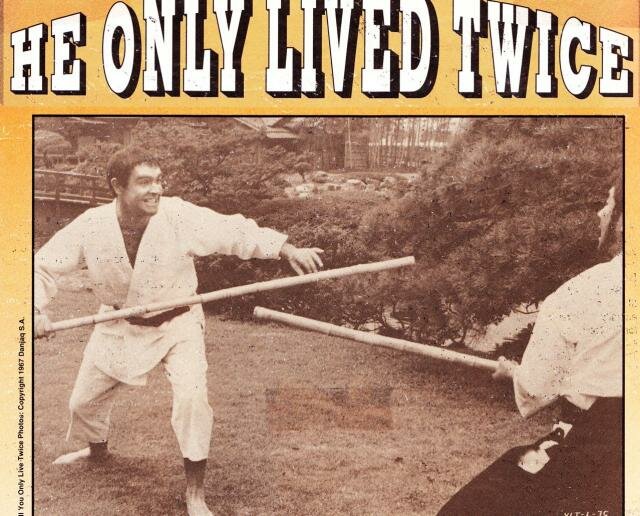
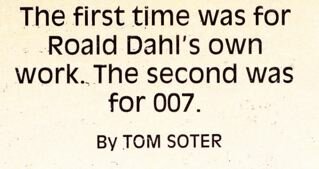 Roald Dahl hated screenwriting. "If you've got enough money to live comfortably, there’s no reason in the world to do a screenplay. Harry Curtis once said that the only reason anybody ever does a screenplay is because you’re paid so much money and because you're hungry. It's an awful job.” And yet, before he died on November 23, 1990, Dahl had written some of the genre's most notable – or at least lucrative –screen works. In 1959, he adapted his short story "Lamb to the Slaughter" for Alfred Hitchcock Presents; in 1967 and 1968, he authored the screen versions of two Ian Fleming fantasies: the James Bond caper You Only Live Twice and Chitty Chitty Bang Bang, a children's book about a flying car. In 1971, he scripted the film version of his bestselling Charlie and the Chacolate Factory. And just months before his death, he saw his story The Witches adapted by writer Allan Scott and director Nicolas Roeg into a critically acclaimed film, which he reportedly disliked. Roeg noted, however: "Roald is a great, great storyteller. I don't know anyone comparable to him." The Man’s Life
Roald Dahl hated screenwriting. "If you've got enough money to live comfortably, there’s no reason in the world to do a screenplay. Harry Curtis once said that the only reason anybody ever does a screenplay is because you’re paid so much money and because you're hungry. It's an awful job.” And yet, before he died on November 23, 1990, Dahl had written some of the genre's most notable – or at least lucrative –screen works. In 1959, he adapted his short story "Lamb to the Slaughter" for Alfred Hitchcock Presents; in 1967 and 1968, he authored the screen versions of two Ian Fleming fantasies: the James Bond caper You Only Live Twice and Chitty Chitty Bang Bang, a children's book about a flying car. In 1971, he scripted the film version of his bestselling Charlie and the Chacolate Factory. And just months before his death, he saw his story The Witches adapted by writer Allan Scott and director Nicolas Roeg into a critically acclaimed film, which he reportedly disliked. Roeg noted, however: "Roald is a great, great storyteller. I don't know anyone comparable to him." The Man’s Life 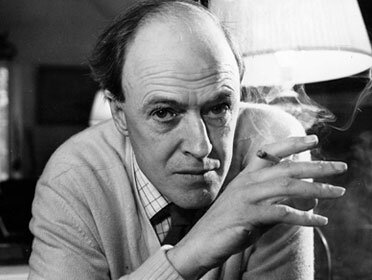 Roald Dahl: "a great, great storyteller."
Roald Dahl: "a great, great storyteller."
Dahl was born 75 years ago in Wales, the son of Norwegian parents. A Royal Air Force fighter pilot during World War II, he was seriously wounded while flying over the Libyan desert. The novelist C.S.Forester (whose literary creation Admiral Horatio Hornblower was later the model for Star Trek's Captain James T. Kirk) heard the tale and suggested Dahl write it up as a story for the Saturday Evening Post. The success of that led to a career in writing: three novels, nine books of short stories, 19 children’s books and numerous screenplays and TV series.
Directed by Hitchcock for his TV show, Dahl's adaptation of "Lamb to the Slaughter" — in which a wife (Barbara Bel Geddes) murders her husband with a leg of' lamb and destroys the evidence by cooking it and serving it to the investigating policemen – is typical of his macabre sense of humor. It also became one of the series' most famous installments. In 1961, Dahl hosted a Twilight Zone clone called Way Out, and in the early '70s, his fantasy tales were dramatized by others on Roald Dahl's Tales of the Unexpected. Through it all, the writer led a rocky life that left him slightly bitter.
Married to actress Patricia (The Day the Earth Stood Still) Neil in 1953, he nursed her through a series of debilitating strokes in the mid-1960s (their story was the subject of a TV-movie starring Dirk Bogarde as Dahl). The two divorced in 1983. Dahl, who had a son and three daughters by Neal, then married Felicity Ann Crosland.
He became involved in screenwriting almost by accident. In the 1960s, he "wrote an original film script for David [Picker], the head of United Artists at that time, [scheduled to star] Jackie Cooper and [be] directed by an unknown director, Robert Altman," he recalled. "I was writing stories and minding my own business when Altman and Cooper flew out from Los Angeles with this little plot and begged me to do it. In the end-to get rid of them, because they were drunk all the time-I did it. Altman said, 'When you write it, the only condition is that I direct it.' So, I wrote it. United Artists loved it and offered me $150,000 for the first draft, but they wouldn't have this unknown director Altman.
"They bought it and cast Gregory Peck," Dahl added. "[It was] a very expensive film. They all went to Switzerland, shot about 200 feet of film in 10 weeks and lost a fortune because they had a bad director. So, that was cancelled, never made. It had a temporary title, like The Bells of Hell Go Ding-a-Ling-a-Ling. It's still on the shelf.
"The important thing about that little story is that Picker saw this screenplay, which had been made up from nothing. At the time, he was talking to [Bond movie producers] Albert R. ('Cubby') Broccoli and [Harry] Saltzman about how to do You Only Live Twice. They thought of me and I got a call from Broccoli: 'Would you do a Bond script?' I said yes and went up to see them. There were Broccoli and Saltzman, and they said, 'You know, it will have to be completely invented. You can use the Japanese scenes and the names of the characters, but we need an entirely new plot.' So, I said, 'Well, all right.' They picked up the phone, called Swifty Lazar, my agent in California, and closed the deal, and I went away and started writing it. That’s how I got the job. David Picker was obviously impressed by the [Bells] screenplay.” 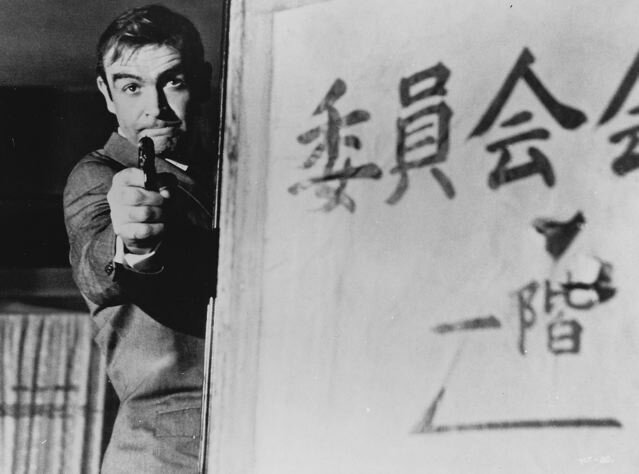
Sean Connery as 007 in Dahl's You Only Live Twice: "Fleming's worst book."
The Novelist’s Plot
You Only Live Twice was a transitional picture for the Bond series. It marked the on-screen introduction of Blofeld, head of the evil organization SPECTRE, the absence of four-time screenwriter Richard Maibaum and four-time editor Peter Hunt (both of whom would later re-enlist) and the first sign of rifts between co-producers Broccoli and Saltzman.
Dahl felt You Only Live Twice was an odd title to adapt. “It was Ian Fleming’s worst book, with no plot in it which would even make a movie,” he noted. Throughout most of the story, 007 wanders around Tokyo, taking in the sights and recuperating from his wife’s death (which occurred in the previous novel, On Her Majesty’s Secret Service, to be filmed later). Near the story’s end, Bond uncovers evidence that his old foe, Ernst Stavro Blofeld, is running an “island of death” for suicide-prone Japanese. A bizarre encounter between Bond, in a fisherman’s disguise, and Blofeld, dressed as a knight, climaxes the story. Blofeld is killed and Bond is reported dead; actually, the agent has amnesia and retires to the simple life of a Japanese fisherman.
Broccoli and Saltzman tried several screenwriters when Maibaum was unavailable. Finally, they offered the job to Dahl. "So, I did it, and we had two or three script conferences with Cubby and Harry. Harry would usually nod off to sleep in the middle." Dahl was given a Bond formula to write You Only Live Twice to: "Bond has three women through the film: If I remember rightly, the first gets killed, the second gets killed and the third gets a fond embrace during the closing sequence. And that's the formula. They found it's cast-iron. So, you have to kill two of them off after he has screwed them a few times. And there is great emphasis on funny gadgets and love-making.”
em; a mini-helicopter (“Little Nellie”) armed with missiles (a sort of airborne Aston Martin); a suction-cup wall climber; a cigarette that fired explosive bullets; and a volcano that changed into a rocket-launching pad. 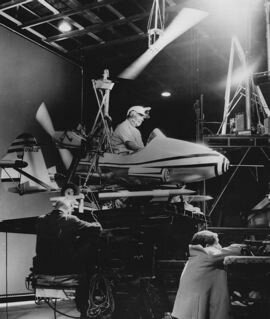
Gadgetry: Little Nellie on the set.
The volcano was the most fantastic set a Bond movie had spotted until then, costing $1 million of the film’s $10 million budget. Designed by Ken Adam, the idea of it came about by accident. “We had a writer,” Broccoli told a gathering at the Museum of Modern Art in 1979, “who came up with the idea of having these Ninja-like Japanese characters crawling all over Tokyo, and it just wouldn’t work. So, we flew all over Japan with a fleet of kamikaze pilots,, and that’s when we found the volcano.”
That set became the movie’s centerpiece, around which Dahl built his story. The shooting schedule was set before the screenplay was completed. After signing to write it, Dahl had to deliver the first draft in six weeks; the second, 14 weeks after that.
"The main problem was the plot," he said. "I didn't know what the heIl Bond was going to do." Unlike later films in the series, which were often written by committee, Dahl's was finished alone and pretty much from scratch, with a basic plot that foIlows the outline of the first movie in the series, Doctor No.
''I'm sure today when it's getting so tough to think of new ideas and new tricks for Bond that you do need a lot of heads [to come up with new ideas]," he comments. "No one man can think of new gimmicks. But in those days, it wasn't very much of that."
Broccoli told the writer to start with Bond's "death" and burial at sea, staged to fool his enemies. "My guess is that it was the idea of Mr. [Harold Jack] Bloom," said Dahl, citing the prolific TV writer who earned an "additional story material" credit on the finished film. "They had probably-and hadn't told me--commissioned a screenplay from him, and it hadn't been any good, but they picked out that jdea and possibly one or two others which they had asked me to put in. So, Bloom had a right to some kind of credit. I never worked with him. The first time I heard of Bloom wanting a share in the credits was after the film had been cut and I was told that there would be a share. 1 said, 'Well, there's no way anyone's going to share the full credit. ' There was a fight about that, and then, they gave him what you see."
The Writer's Bond
To direct, the producers chose Lewis Gilbert, a former child actor who had a hit in 1966 with Alfie. Noted Dahl: "I've written quite a few films [since then] and he is the only director I ever worked with who is any kind of a decent fellow. He was absolutely splendid. He not only helped in script conferences, but had some good ideas and then left you alone, and when you produced the finished thing, he shot it. Other directors have such an ego that they want to rewrite it and put their own dialogue in, and it's usually disastrous. What I admired so much about Lewis Gilbert was that he just took the screenplay and shot it. That's the way to direct: You either trust your writer or you don't.
"I can remember Tokyo," he continued, “when we were shooting some of those later sequences, and they needed another scene or a rewrite. I met with Lewis down in the bar in the Hilton Hotel and gave them something like 20 pages. He literally flipped through them and then said, 'That's fine.' And that's it. He still had complete control of everything. I was most impressed. And of course, I was impressed with the fact that when they do dangerous things-lifting cars up with magnets-they shoot them live; they don't use models unless they have to."
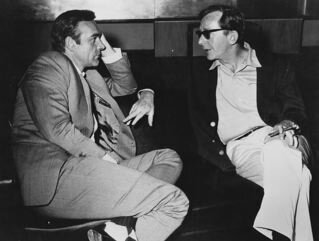
Connery confers with director Lewis Gilbert.
Curiously, Dahl had little to do with Blofeld's creation on screen: “I simply wrote, 'Blofeld.' It was, to my mind, the director’s job to decide,' with Cubby, how the first sight of Blofeld in the film is presented." Only his legs were shown for the first two-thirds of the story – partly because Donald Pleasence, who played the villain, didn't join the cast until late in the picture.”
The filming in Japan, Hong Kong and Pinewood Studios in England ran over schedule for a total shooting time of six months. Part of the problem was that wherever Connery went, he was followed by the press, fans and hangers-on, who even trailed him into a public bathroom. The tension began to spill over into the actor's dealings with others in the film's company.
"One saw each other every day," said Dahl, who was present during the filming to handle rewrites. "Nobody ever got close to Sean, you know. He's Scottish and they have a peculiar kind of reticience. The crew and Freddie Young – the chief cameraman and a lovely fellow – and everyone else alll stood a round at the end of a hot day and had drinks and beer, and Sean accepted these. He was the only man making a million in the film and he never stood anyone a round. This was known. They all talked about it. He is not an attractive personality.
"Sean happened to fit exactly into the Bond image," Dahl added. "Somehow, Bond didn't need personality, he was just a tough guy. The quips were all given to him by us, you see. We went out of our way to give him quips that were incredibly cllever, but they only had to be spoken with a straight poker face. Thhere was damn little acting for him to do. He walked through it, you know. Literally. "He was a very foolish fellow to get bored by Bond because it made him. It made his life and it made his fame. If it had been me, I wouldn''t have gotten big-headed and gone off and said, 'I'm going to do my own thing now. You can all go to hell.'I would have stuck with them and seen it through, not let them hire some other actor. [George Lazenby] was a disaster.
"I don't think Sean behaved very well on this film He finally demanded enormous [amounts of money] and let it be known he was giving a million to' charity. WeII, that was just a tax deal. Don think he didn't get exactly what he wanted out of it. No, I don't think Sean Connery's a complicated creature at all. He's an absolutely straightforward, rather dull Scotsman."
Dahl and Gilbert got along very well, however, with the author turning in numerous rewrites on request. "I had to foIIow them around because they constanty wanted new bits of dialogue," Dahl explained. "The way the thing worked out, they were shooting and they said, 'We need it, here or there.' So, I went to Japan with them, stayed the whole time there and generally had a good time. I didn't get into the acrimony between Cubby and Harry, which was just beginning then. Cubby was marvelous with us; he took that one over. As far as I can remember, he was in charge. Harry put in an appearance, but he didn't get too close to Cubby.

Connery and Charles Gray
"I think [the Bond movies] were at their peak then because they had practiced for about four or five of them and everyone knew exactly what to do. It was a very well-oiled machine by then and this was their last big one with Connery [though he later returned to the role]. You also had the feeling that they had the money in the bank and they were going to make a fortune, so no money was spared in its making. You went everywhere by helicopter. If the location was 10 miles away and rather hard to get to-like a Japanese fishing village-you would go there by helicopter and find that they had already dug a helicopter landing pad out of a cliff. It was weIl-organized; they were in on a gold mine and they knew it. They quite rightly never skimped on the money, never."
The Legend's Legacy
One of the rewrites involved an idea of Broccoli's. "After I had finished the screenplay," recalled Dahl, "Cubby had seen this extraordinary helicopter. It had nothing to do with the Bond films at all. This thing was amazing. Cubby had happened to see it, and he said, 'We've got to have this in the film. It's so good.' He showed it to me and said, 'Go back and put it in.' "That was actuaIIy good filmmaking; it was one more gadget. Of course, I knew that you couldn't take that to bits and put it together again [in a suitcase] the way they.did [in the movie]. That's a bit of artist's license, so I said the only way to do this and have fun with it is to have it in a box. But the fact remains that it's a marvelous little airplane and that it did exactly what you say. There was no cheating, except that it couldn't be taken to bits.
"The whole thing was gadgets. I came in one morning and said to them, 'Wouldn't it be rather fun when Bond goes in the office of the bad Japanese, and the person at the typewriter is pressing the keys and moving the lamp hanging from the ceiling and keeping it on Bond's head the whole time?' They said, 'Great! Have it in.' They loved gadgets-although now I think they're depen ing a little too much on them, instead of on plot and story."
When the film opened in 1967, most critics cited Dahl's excellent pacing in the first two-thirds of the movie. "I was trained to move quickly in short stories, you see. You can't lose your reader," noted the writer, who did admit that he was disappointed with the movie's explosive climax. "You know, you hardly write [scenes like] that at all You just say,·'Fight in volcano,' and then, they have as many people as they can hire. I think it's a bit muddy myself. I would much rather have seen a cleaner ending, but this is traditional. That's not written. They just want a big fight at the end and say, 'Leave it to us.' It's a muddy, sloppy way of finishing and you could have been more subtle."
Dahl never wrote another Bond adventure simply because "they never asked me. If you really want to know, I was rather surprised that they didn't. I think I did a good job, and it was done out of nothing. The others were much easier to do because Fleming had given them good plots."
Nonetheless, the writer was hired by Broccoli to concoct a script out of Fleming's only children's book, Chitty Chitty Bang Bang. It was not a happy experience. "I was very badly treated by Cubby on that one. I worked with Ken Hughes [who directed part of the Bond spoof Casino Royale], who rewrote the whole thing. They spent $18 milion on it and never got it back. Cubby used me to develop the entire story with Hughes day after day, and I couldn't understand why he didn't take notes while I talked. Hughes completely rewrote my script and Broccoli did nothing to interfere.
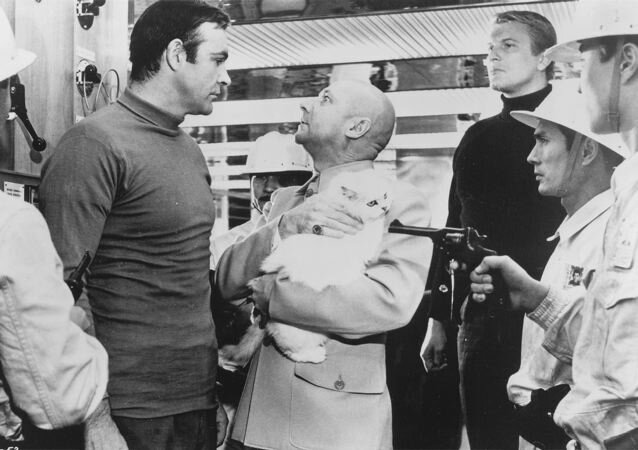 Bond (Sean
Bond (Sean
Connery) face-to-face with Blofeld (Donald Pleasence).
"Ken Hughes is a compulsive director/writer," Dahl said. "The whole thing was botched up. It was a disaster. This is the problem he makes: He's a director, not a writer. Cubby hired him because he did have a minor success with a film about Oscar Wilde. He should have had Lewis Gilbert. Then, he would have had something."
Dahl was also bitter about his adaptation of Charlie and the Chocolate Factory (retitled Willy Wonka and the Chocolate Factory for the screen). "There was a dreadful director named Mel Stuart, who really screwed the whole thing up. I mean, you've got a bestseller book, which is still a bestseller to this day, and the film is a disaster, basically. I did the screenplay, but that doesn't matter. They changed it.”
By 1980, Roald Dahl had "resigned" himself to the life of a bestselling children's book author, and recalled his 007 days fondly. "You Only Live Twice was fun to do. It was the only screenplay I've ever done II which was fun, and it was some time ago. I turn them down all the time. What's it about? You see, everyone tells you what to do, so the serious writer actually hates it. Many of them have gone out to Hollywood and been ruined, or come back hating it.”
 A LOOK BACK When I was preparing my book on the James Bond movies in 1979, I wrote to the novelist Roald Dahl, who lived in England at the time, and asked him if he would talk with me about his experiences as the screenwriter for You Only Live Twice. He wrote me back a brief note that said, esentially, "if you're ever in England, look me up." I took this as a polite brushoff. But I happened to be in the U.K. in 1980, and I called him. He didn't seem any too pleased to hear from me but did agree to talk. Once he started going, he was quite expansive. After I finished the interview (and a number of others, including talks with Bond folk like Tom Mankiewicz and Ken Hughes), I wrote the book – and then the project fell into limbo. My publisher, fearing a lawsuit, dropped out of the deal, and I was left with an unpublished manuscript. When Dahl died in 1991, I saw an opportunity to use some of the interview material; so I sold a revised version of the chapter on You Only Live Twice as an article on Dahl and the movie to the magazine Starlog. In an ironic twist, that led to the publication of my Bond book. A small (very small!) publishing house (more of a hut then a house, actually) saw a note in the article that explained that the piece was adapted from an unpublished book on the 007 movies. The publisher, Ed Gross, contacted me, we agreed to go forward with the book, and the rest is the stuff of legend (at least in my household). Bond and Beyond was published in 1993, and if you're interested, I still have a copy or two I could sell you (no kidding: see https://tomsoter.com/?q=node/128).
A LOOK BACK When I was preparing my book on the James Bond movies in 1979, I wrote to the novelist Roald Dahl, who lived in England at the time, and asked him if he would talk with me about his experiences as the screenwriter for You Only Live Twice. He wrote me back a brief note that said, esentially, "if you're ever in England, look me up." I took this as a polite brushoff. But I happened to be in the U.K. in 1980, and I called him. He didn't seem any too pleased to hear from me but did agree to talk. Once he started going, he was quite expansive. After I finished the interview (and a number of others, including talks with Bond folk like Tom Mankiewicz and Ken Hughes), I wrote the book – and then the project fell into limbo. My publisher, fearing a lawsuit, dropped out of the deal, and I was left with an unpublished manuscript. When Dahl died in 1991, I saw an opportunity to use some of the interview material; so I sold a revised version of the chapter on You Only Live Twice as an article on Dahl and the movie to the magazine Starlog. In an ironic twist, that led to the publication of my Bond book. A small (very small!) publishing house (more of a hut then a house, actually) saw a note in the article that explained that the piece was adapted from an unpublished book on the 007 movies. The publisher, Ed Gross, contacted me, we agreed to go forward with the book, and the rest is the stuff of legend (at least in my household). Bond and Beyond was published in 1993, and if you're interested, I still have a copy or two I could sell you (no kidding: see https://tomsoter.com/?q=node/128).
[[wysiwyg_imageupload:1496:]]
[[wysiwyg_imageupload:1497:]]
